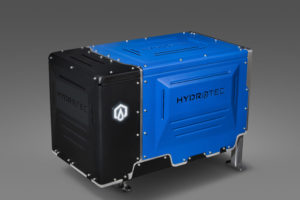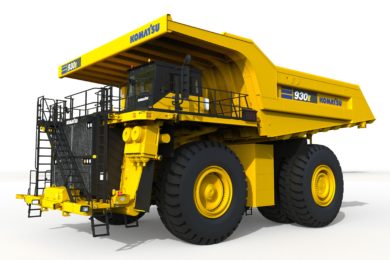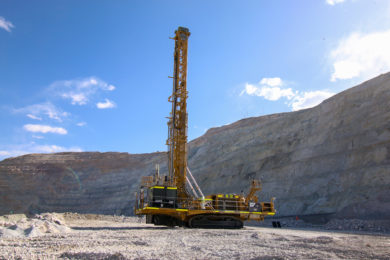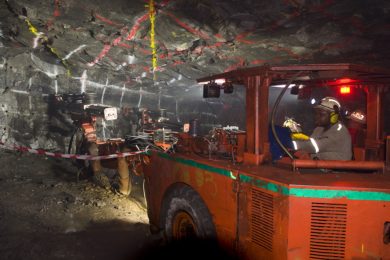General Motors and Komatsu have announced that they will co-develop a hydrogen fuel cell power module for Komatsu’s 930E electric drive mining truck, cited as the world’s best-selling ultra-class haul truck. GM, a leader in hydrogen fuel cell technology, and Komatsu, a global manufacturer of mining and construction equipment, will jointly design and validate the technology.
The statement said: “Lightweight and quick to refuel, hydrogen fuel cells are ideal for electrifying applications traditionally powered by diesel engines. Hydrogen provides an effective method to package large quantities of energy onboard the vehicle, without compromising payload carrying capacity. Additionally, fuel cells provide an excellent zero tailpipe emissions solution for vehicles with extreme hauling requirements, like the Komatsu 930E mining truck, with its nominal payload of 320 tons. These vehicles typically operate at a single mine throughout their life, which simplifies the challenges of sizing and deploying an effective hydrogen refueling infrastructure to service the vehicle fleet.”
“At GM, we believe fuel cells can play an integral role in a zero-emissions future, helping to electrify heavier-duty applications, beyond passenger vehicles,” said Charlie Freese, Executive Director of GM’s Global HYDROTEC business. “Mining trucks are among the largest, most capable vehicles used in any industry, and we believe hydrogen fuel cells are best suited to deliver zero emissions propulsion to these demanding applications.”
The new fuel cell-powered 930E will be powered by over 2 MW of GM HYDROTEC power cubes

Komatsu’s fuel cell-powered mining trucks it says will provide an additional pathway for decarbonisation beyond battery-trolley or battery-static charging solutions, without the need for additional charging infrastructure within mines.
Komatsu has set a target of reducing its global emissions by 50% by 2030 and a challenge target of achieving carbon neutrality by 2050. The plans for achieving these goals include reducing and eliminating emissions within the company’s product offerings, as well as in the company’s facilities and production of its products. Komatsu also works closely with its customers on reducing and eliminating emissions during product use through optimisation programs supported by Komatsu technology and service solutions. GM’s target is to be fully carbon neutral in both products and operations by 2040.
“Finding new ways to power the equipment our customers need to do the vital work of mining and construction is a critical part of our commitment to supporting a more sustainable future,” said Dan Funcannon, Vice President of North America Engineering and Development for Komatsu. “This is essential work that requires cross-industry collaboration, and we are excited to be working with GM on this important solution for a haulage offering without tailpipe emissions.”
GM and Komatsu intend to test the first prototype HYDROTEC-powered mining vehicle in the mid-2020s at Komatsu’s Arizona Proving Grounds (AZPG) research and development facility. This vehicle will be powered by over 2 MW of HYDROTEC power cubes. When asked whether the fuel cell module will be factory fitted as well as being available as a retrofit option, Funcannon stated: “We are developing what we’ve called a Power Agnostic platform…our intention is to provide the platform to be able to adapt to numerous power technologies, including hydrogen fuel cell. And our intent is to work with our customers to determine if retrofit of earlier models is technically and commercially feasible.”
Komatsu also told IM that the truck will use both the hydrogen fuel cells as well as battery power – so it will be a Fuel Cell Electric Vehicle (FCEV). The fuel cells represent the primary power source with the battery used for load balancing as well as capturing energy during retarding, similar to an automotive EV.
GM has been conducting fuel cell research and product development for more than 50 years and says it is one of the only companies with advanced, homegrown technology platforms for both lithium-ion batteries and hydrogen fuel cells. GM and Komatsu believe these complimentary technologies can help spur the adoption of lower-emission mobility solutions and help other industries beyond passenger vehicles meet their sustainability goals. Funcannon additionally told IM on why GM was chosen: “They have decades of experience in the research and development of fuel cell technology, and we believe they’re best suited to help us, help our customers meet their sustainability goals.”
That said, this is not the first time hydrogen fuel cells have been used to power a 930E mining truck – in 2021, truck number DT74 at Anglo American’s Mogalakewna platinum mine began operation using eight Ballard FCveloCity®-HD 100 kW fuel cell modules working with a WAE 1.1 MWh battery. However, that project was conducted by First Mode in partnership with Anglo American and Komatsu was not directly involved other than providing some technical assistance. First Mode is in the process of converting a second 930E at its proving grounds in Centralia, Washington, afer which it will move onto the 830E.










